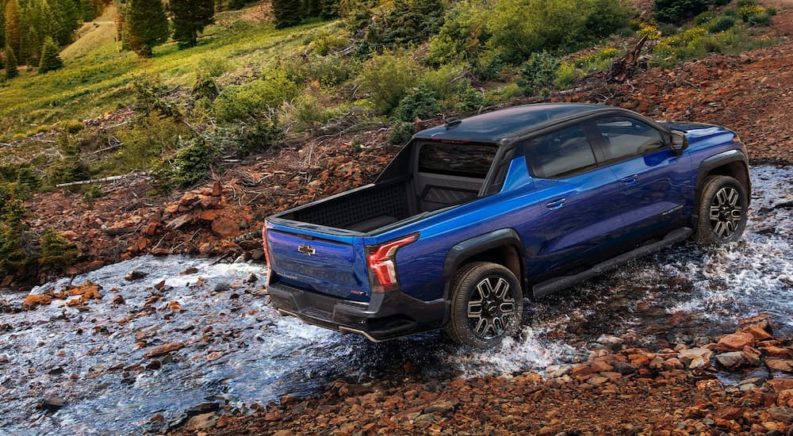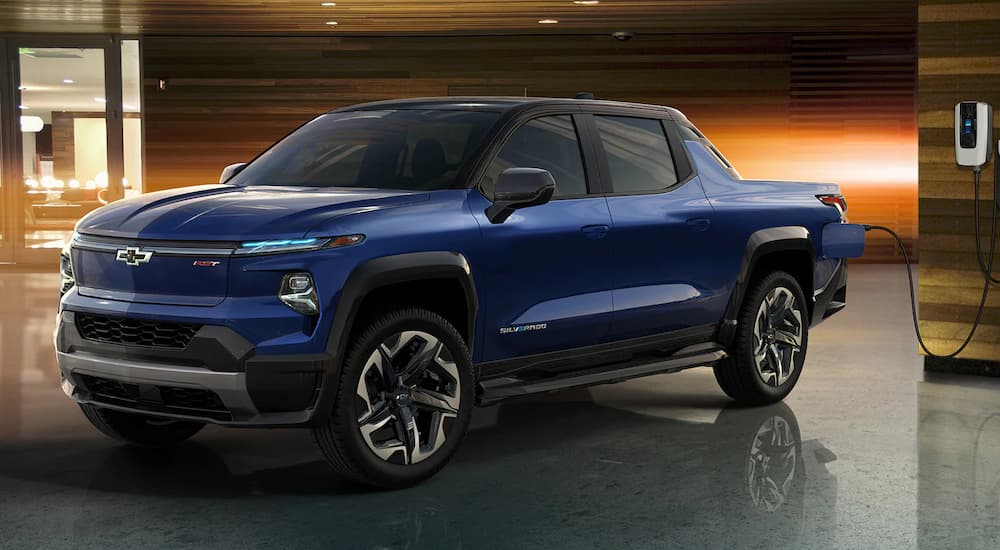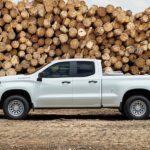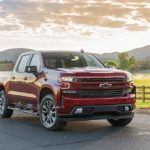If everything goes according to the auto manufacturers’ plans, we’ll soon be immersed in a fully electric future. While many coupes and sedans have risen to the challenge, and SUVs are starting to make their way into the electric vehicle (EV) market, the first two electric trucks to face off are the 2024 Chevrolet Silverado EV vs 2022 Ford F-150 Lightning.
The media has understandably become a whirlwind of information, as we’re pelted with new details about what these technologically advanced trucks will include to make our lives easier. There are so many details swirling around these days that it can often be confusing to recall which amazing feature is paired with which upcoming electric truck.
To keep things simple, consider this your preliminary guide to telling the two apart. Sure, the labeling on the exterior of the truck will be a dead give-away, but what about when you’re searching the internet alone, trying to remember which truck had that one thing that you really liked? While more details about the Silverado EV and F-150 Lightning will surely be released as we head towards each truck’s respective market release, the following details should help you get the two sorted before it’s time to start shopping.
Which Can Do What? Deciphering the Capability of the Silverado EV and F-150 Lightning
One of the most important details for pickup truck drivers is capability. How much can you tow? How big is the box? How much can you put in the bed? How many passengers can safely ride inside the cab? For most shoppers, these are the first things that need to be considered when selecting the perfect truck for their lives.
The 2024 Chevy Silverado EV has been billed as a capable truck, and the early figures indicate that is correct. Chevrolet plans to release the Silverado EV in stages. The first version, offered as the WT trim, will be capable of towing up to 10,000 pounds. Future editions will include up to 20,000 pounds of towing capacity.
Chevy also notes that the Silverado EV will provide up to 660 horsepower and 780 lb-ft of torque, giving it plenty of presence to handle tough situations, such as handling sloppy off-road conditions and hauling up to 1,300 pounds of payload.
The Ford F-150 Lightning has been announced with a towing maximum of 10,000 pounds for the early XLT and Lariat trims, with payload capacity topping out at 2,000 pounds. The Lightning’s power system will offer 563 horsepower and 775 lb-ft of torque.
Interestingly enough, both vehicles indicate a 0-60 mile per hour acceleration time of just over 4 seconds. Could EV truck racing become a future sport?
How Far Can They Go? Examining Range and Charging
Once upon a time, you asked about gas mileage. How many miles a truck got per gallon of gasoline would help you determine how often you needed to stop at the gas station to fuel up. That’s about to change.
It’s no secret that EVs need to be plugged into the wall to charge, just like your cellphone, laptop, and cordless tools. It seems simple enough, but at the same time, it can be very intimidating for people who aren’t necessarily next to an electric socket all day. What happens if you run out of charge? You can’t just carry an extra gallon of electricity in the truck bed so you can limp to a gas station. That is true, but the possibility of running out of charge is largely outweighed by how easy it is to charge your electric truck.
The Chevy Silverado EV has an estimated range of 400 miles per charge. Additionally, tools in the cabin and in Chevy’s EV app will help drivers understand how much charge is left in their truck, along with current usage. You’ll also be able to find nearby spots for a quick charge. For those who drive less than 400 miles a day, charging your Silverado EV will be as simple as plugging it into a regular socket at home at the end of the day.
The Ford F-150 Lightning offers a Standard Range and an Extended Range battery. The Standard option has a range of 230 miles, while the Extended version provides up to 300 miles of travel. Ford also offers tools such as the “Power My Trip” feature, which helps drivers choose routes that make sense for their load and power level, offering charging opportunities along the way. Additionally, the at-home Ford Charge Station Pro allows drivers to gain up to 30 miles of charge per hour when used with the Extended Range battery.
Also of note: both electric trucks can be used as mobile power stations to charge tools, other EVs, and even your house! Ford’s Pro Power Onboard feature provides 11 electrical outlets throughout the truck for a total of 9.6 kW of power, while the Silverado EV can provide up to 10.2 kW of power from 10 outlets. In case of severe power failure, Ford claims the Lightning can power your entire home for up to 10 days if you ration power wisely, and Chevy’s larger battery should last even longer.
The Cool Stuff: What’s Fun About the Silverado Ev and F-150 Lightning
Once all of the practical details are sorted, it’s time to check out the fun stuff. That is, the features and accessories that make driving one truck more exciting than another. While comfort and convenience features are often considered luxuries, there is quite a bit of practicality in them.
Consider, for example, the front trunk. Neither the 2024 Chevy Silverado EV nor the 2022 Ford F-150 Lightning have an engine, thus leaving a very large empty space under the hood. Chevy calls this the eTrunk and has made it lockable and weatherproof, with a variety of configurations that can help store various tools and equipment safely. The Ford version is the whimsically-named Mega Power Frunk. Measuring in at 14.1 cubic feet with 400 pounds of payload capacity, it does manage to earn its name.
The Chevy Silverado EV features a 17-inch diagonal LCD freeform infotainment system, an 11-inch diagonal driver instrument display, and Head Up Display measuring up to 14 inches. While it’s not quite the robot car of the future, it does provide a significant amount of detail to drivers at all times. It offers hands-free start as well as Super Cruise hands-free driving, even when trailering. Over-the-air updates are enabled by GM’s new Ultifi software, which means software and programming updates will be seamless and effortless. Chevy also offers a pass-through bed door, known as the Multi-Flex Midgate, which will allow the truck to carry items up to 10 feet in length.
Ford’s Lightning offers a smaller (but still quite large) 15.5-inch portrait-layout touchscreen infotainment system. Functioning in much the same manner as a tablet, this screen is also accompanied by a digital instrument and productivity display. In fact, the display changes based on the drive mode selected. BlueCruise hands-free driving is also available with the Lightning, with over 100,000 miles of roadways in the US and Canada already mapped out as Hands Free Blue Zones. Connectivity is further enabled with Ford’s SYNC 4 Technology, which adds enhanced voice recognition to the mix.
Will there be more cool toys? Absolutely. Ford is starting to tease details about enhanced trailering capabilities, while Chevy continues to iron out the features of the first release WT and RST trims.
More Than a Badge: 2024 Chevy Silverado EV vs 2022 Ford F-150 Lightning
Historically speaking, we thought of Chevys as Chevys and Fords as Fords. Like The Beatles and Elvis, drivers have previously chosen one brand and stuck with it. Going electric gives us a new opportunity to really consider the pros and cons of every truck we see. We’re accustomed to being able to customize our trucks, thanks to both Chevrolet and Ford offering plenty of trims, engines, and body configurations.
But electric trucks are a little different. They’re less customizable at this point, and that means drivers will need to pay attention to what each truck can do for them. Which makes the most sense for their daily route? Which has the ability to take on the right amount of work?
It will be interesting to see how the electric truck evolves from these two early arrivals. With Tesla, Rivian, Bollinger, GMC, and seemingly every known and unknown manufacturer working on their own version of an electric truck, the world of driving pickup trucks may very well change completely. Over time, each brand will develop its own identity, but for now, we’re at the dawn of a new era in which each manufacturer has a fresh chance to establish its brand.






